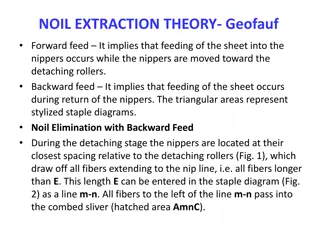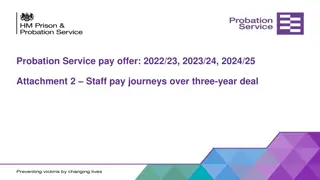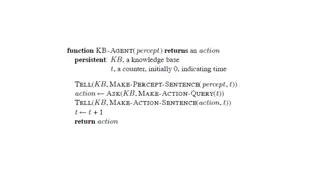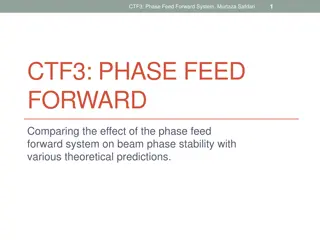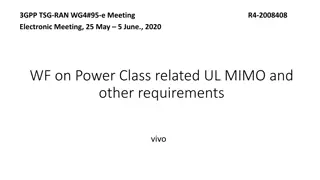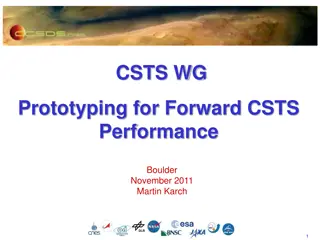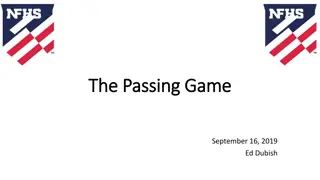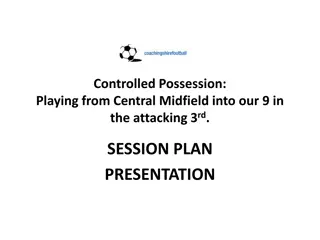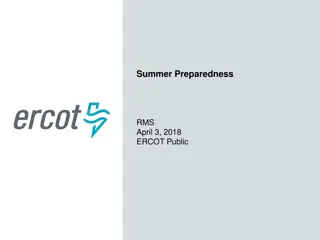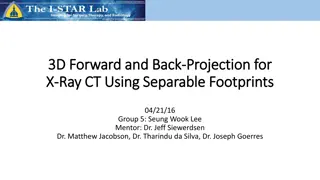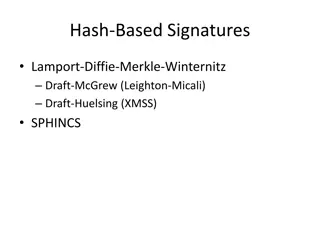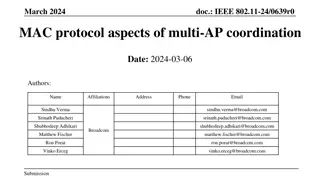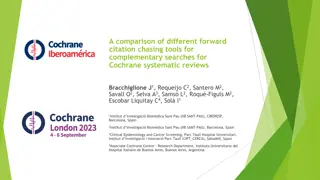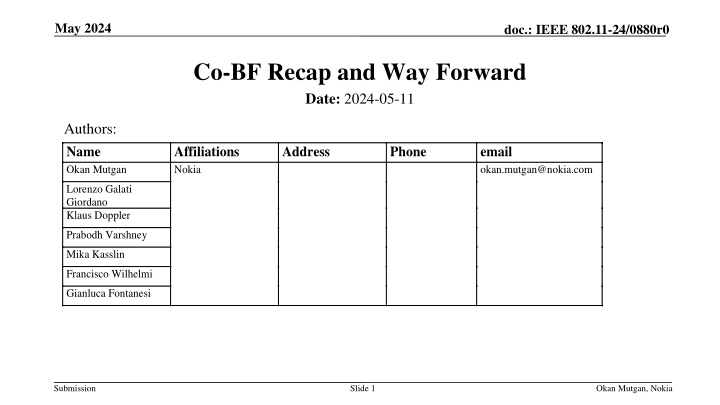
IEEE 802.11-24/0880r0 Coordinated Beamforming Recap and Objectives
Explore the IEEE 802.11-24/0880r0 document discussing Coordinated Beamforming (Co-BF) in dense scenarios with high interference, aiming to improve latency and spatial domain coordination. Learn about the key proposals, when Co-BF is useful, and why it is essential for performance enhancement in wireless communication standards.
Download Presentation

Please find below an Image/Link to download the presentation.
The content on the website is provided AS IS for your information and personal use only. It may not be sold, licensed, or shared on other websites without obtaining consent from the author. If you encounter any issues during the download, it is possible that the publisher has removed the file from their server.
You are allowed to download the files provided on this website for personal or commercial use, subject to the condition that they are used lawfully. All files are the property of their respective owners.
The content on the website is provided AS IS for your information and personal use only. It may not be sold, licensed, or shared on other websites without obtaining consent from the author.
E N D
Presentation Transcript
May 2024 doc.: IEEE 802.11-24/0880r0 Co-BF Recap and Way Forward Date: 2024-05-11 Authors: Name Okan Mutgan Affiliations Nokia Address Phone email okan.mutgan@nokia.com Lorenzo Galati Giordano Klaus Doppler Prabodh Varshney Mika Kasslin Francisco Wilhelmi Gianluca Fontanesi Submission Slide 1 Okan Mutgan, Nokia
May 2024 doc.: IEEE 802.11-24/0880r0 Background Multi-AP coordination (MAPC) is one of the most discussed protocol enhancement for 802.11bn. MAPC may enable the development of new features, among them Coordinated Beamforming (Co-BF). Co-BF enables a framework for inter-BSS spatial domain coordination with radiation beams (towards own users to serve) and nulls (towards neighboring users to mute). Co-BF has been already extensively discussed in TGbe [1-5], UHR SG [6-10], and TGbn [11-16]. Submission Slide 2 Okan Mutgan, Nokia
May 2024 doc.: IEEE 802.11-24/0880r0 Objectives of this contribution Recap of existing Co-BF key proposals When is Co-BF useful? Why do we need Co-BF? Submission Slide 3 Okan Mutgan, Nokia
May 2024 doc.: IEEE 802.11-24/0880r0 Recap of existing Co-BF key proposals TGbe UHR SG TGbn Inter-BSS/OBSS coordination set establishment and maintenance [1], [3] [9], [10] [11] CSI acquisition from devices both in own and inter-BSS/OBSS [1], [3], [4] [7], [10] [11], [15] Allocation and communication of nulling capabilities to enable concurrent transmissions without power reduction Performance [1], [3], [4] [16], [11], [15] [2], [5] [6], [8], [9] [12], [13], [14], [16] Submission Slide 4 Okan Mutgan, Nokia
May 2024 doc.: IEEE 802.11-24/0880r0 When is Co-BF useful? Dense scenarios with high interference There must be inter-BSS interference to null where, in addition, the STAs in OBSS have delay-sensitive traffic Nulls should be placed towards delay-sensitive STAs where, in addition, the served STAs enjoy high SNRs Placing a radiation null reduces the degrees of freedom (d.o.f.) for beamforming, and thus the beamforming gain, penalizing cell-edge STAs where, in addition, the number of spatial streams to serve is reasonably smaller than the available d.o.f. at the antenna array in the AP As for the Shannon-Hartley theorem, multiplexing gains are linear, while SINR gains are logarithmic in terms of capacity, and the later gains should not come at the expense of the former Submission Slide 5 Okan Mutgan, Nokia
May 2024 doc.: IEEE 802.11-24/0880r0 Why do we need Co-BF? To improve worst-case latency by making devices in OBSS invisible to each other, thus enforcing full spatial reuse and significantly reduce contentions o C-SR is a simpler mechanisms, but it entails power reduction which might be detrimental in dense environment [8]. o Preemption is effective but it significantly impacts halted transmission. o MLO reduces latency by operating in multiple links, however, in dense scenarios, worst- case latency (99th-percentile) may deteriorate, as MLO tend to occupy all the available links occasionally leading overlapping delay-sensitive devices to wait [18]. Submission Slide 6 Okan Mutgan, Nokia
May 2024 doc.: IEEE 802.11-24/0880r0 Why do we need Co-BF? Co-BF may empower already existing functionalities and frames in IEEE 802.11 for addressing UHR PAR objectives o Multiple antennas in current Wi-Fi products are a fact, exploiting them for nulling is a better opportunity than for boosting beamforming gain (limited by EIRP regulation). o Additional overhead for CSI acquisition of inter-BSS devices can be limited o Triggering and performing CSI acquisition of inter-BSS devices is possible building on existing frameworks Submission Slide 7 Okan Mutgan, Nokia
May 2024 doc.: IEEE 802.11-24/0880r0 Co-BF: simulation assumptions [17] Broadband FTP3 model File size = 0.5 MB Offered traffic = 100 Mbps Deployment: 2 ceiling-mounted APs 4x2 antenna array 16 broadband STAs file transfer protocol (FTP) traffic 8 low-latency STAs augmented reality (AR) traffic Per STA traffic time Latency-sensitive AR model File size = 32 bytes Constant arrival rate, frequency = 10 ms Uplink scheduling: APs spatially multiplex as many STAs as possible of a class per TXOP Use remaining DoF (max 4) to suppress interference from low-latency STAs Per STA traffic time Submission Slide 8 Okan Mutgan, Nokia
May 2024 doc.: IEEE 802.11-24/0880r0 Co-BF: potential delay reduction [17] A system w/ or w/o spatial reuse IEEE 802.11ax/be w/o SR IEEE 802.11ax/be with SR Potential IEEE 802.11bn with Co-BF struggles to keep low latency latency often < 3 ms, but it can sometimes exceed 200 ms A system with CBF more aggressive spectrum access inter-BSS interference mitigation ~10x worst-case latency reduction* for delay sensitive traffic (e.g. augmented reality traffic!) * Throughput for broadband traffic almost preserved Submission Slide 9 Okan Mutgan, Nokia
May 2024 doc.: IEEE 802.11-24/0880r0 Co-BF: delay reduction even with imperfect nulling [5] Co-BF nulling attenuation ~8-10 dB, is sufficient to improve worst-case latency [5]. o This can lead to a reduction of CSI acquisition overhead. The worst-case latency benefits are also present with limited Co-BF nulling attenuation o Inter-BSS delay-sensitive devices take anyhow advantage of the advertised spatial reuse opportunity o However, collisions are possible and affect the performance of the devices in the BSS that has granted the spatial reuse opportunity through Co-BF IEEE 802.11ax/be w/o SR IEEE 802.11ax/be with SR Potential IEEE 802.11bn with Co-BF Nulling attenuation [dB] Submission Slide 10 Okan Mutgan, Nokia
May 2024 doc.: IEEE 802.11-24/0880r0 Co-BF summary Co-BF is key for reducing worst-case delay in Wi-Fi, and to enable delay sensitive applications in dense scenarios. Co-BF features has been already extensively studied in TGbe, UHR SG and TGbn, we should capitalize on the effort and further work on defining the details of the feature. Co-BF may build upon and empower already existing mechanisms in IEEE 802.11 to fulfill the UHR PAR objectives. Nulling and associated CSI estimation precision may be relaxed to reduce overhead and complexity. Submission Slide 11 Okan Mutgan, Nokia
May 2024 doc.: IEEE 802.11-24/0880r0 Straw poll Do you believe coordinated beamforming with null steering should be considered for inclusion in the 802.11 TGbn Specification Framework Document (SFD)? Yes No Abstain Submission Slide 12 Okan Mutgan, Nokia
May 2024 doc.: IEEE 802.11-24/0880r0 References 1/2 [1] Coordinated Null Steering for EHT , 19/0811. [2] Performance of Coordinated Null Steering in 802.11be , 19/1212. [3] Coordinated Beamforming/Null Steering in 802.11be , 19/1594. [4] Downlink spatial reuse parameter framework with coordinated Beamforming/Null Steering for 802.11be , 19/1779. [5] Performance of parameterized spatial reuse (PSR) with coordinated beamforming/null steering for 802.11be , 20/0091. [6] Nulling Performance of Coordinated Beamforming , 23/1193r2. [7] Null Beam Steering Based Spatial Reuse , 23/0855r1. [8] Performance of C-BF and C-SR , 22/0776r1. [9] System Level Simulation of Co-BF and Joint Tx , 22/1821r1. [10] Obtaining OBSS channel Information for Multi-AP operation , 23/0854r0. Submission Slide 13 Okan Mutgan, Nokia
May 2024 doc.: IEEE 802.11-24/0880r0 References 2/2 [11] Coordinated Spatial Nulling (C-SN) Concept , 24/0011r0. [12] Coordinated Spatial Nulling (C-SN) Simulations , 24/0012r0. [13] Coordinated Spatial Re-Use and Coordinated Spatial Nulling Follow-Up , 24/0635r0. [14] Residual Interference in CBF , 24/0142r1. [15] TXOP Sharing for C-BF transmission , 24/0387r0. [16] Zero MUI Coordinated BF , 23/1998r0. [17] A. Garcia-Rodriguez et al. IEEE 802.11 be: Wi-Fi 7 strikes back , in IEEE Communications Magazine, vol. 59, no. 4, pp. 102-108, April 2021. [18] M. Carrascosa-Zamacois et al. Understanding Multi-link Operation in Wi-Fi 7: Performance, Anomalies, and Solutions, 2023 IEEE 34th Annual International Symposium on Personal, Indoor and Mobile Radio Communications (PIMRC), Toronto, ON, Canada, 2023. Submission Slide 14 Okan Mutgan, Nokia
May 2024 doc.: IEEE 802.11-24/0880r0 APPENDIX Submission Slide 15 Okan Mutgan, Nokia
May 2024 doc.: IEEE 802.11-24/0880r0 Recap of existing Co-BF key proposals Inter-BSS/OBSS coordination set establishment and maintenance Coordination approaches: Fully coordinated [11] Half-coordinated with sharing and shared APs [11], [1], [3], [9], [10] Evolving the inter-BSS set in 802.11ax, [1], [3] propose the inter-BSS coordination set, which: contains the IDs of all nodes that form part of the inter-BSS coordination set, is configured and updated on the fly in a semi-static manner, and is kept in the memory of each of those nodes Submission Slide 16 Okan Mutgan, Nokia
May 2024 doc.: IEEE 802.11-24/0880r0 Recap of existing Co-BF key proposals CSI acquisition from devices both in own and inter-BSS/OBSS Extending existing trigger frames to address inter-BSS/OBSS devices [3], [4], [7], [10], [11]. Extending NDPA/NDP frames to address inter-BSS/OBSS devices [3], [10], [11]. Extending RTS/CTS frames to address inter-BSS/OBSS devices [4], [7], [15]. Submission Slide 17 Okan Mutgan, Nokia
May 2024 doc.: IEEE 802.11-24/0880r0 Recap of existing Co-BF key proposals Allocation and communication of nulling capabilities in both UL and DL: UL: building upon already existing IEEE 802.11ax PSR [3]. DL: Building upon a PSR-like extension for DL [4]. Building upon IEEE 802.11be Triggered TXOP sharing (TXS) framework [15]. Submission Slide 18 Okan Mutgan, Nokia
May 2024 doc.: IEEE 802.11-24/0880r0 Recap of existing Co-BF key proposals Performance (1/2) Residual interference in Co-BF [6], [14] due to o Interference on the legacy preamble o Interference on the GI Can be treated with [14]: o Extending the beamforming over the legacy preambles o Extending LTFs to separate the effect of the APs in the channel and noise estimation process Nulling and CSI acquisition precision [5], [8] Limited nulling accuracy is still beneficial and may lead to overhead and complexity reduction Submission Slide 19 Okan Mutgan, Nokia
May 2024 doc.: IEEE 802.11-24/0880r0 Recap of existing Co-BF key proposals Performance (2/2) Co-BF vs C-SR [8], [12] In C-SR inter-BSS separation plays a role In C-SR enforced power reduction may reduce the benefits of spatial reuse Submission Slide 20 Okan Mutgan, Nokia


